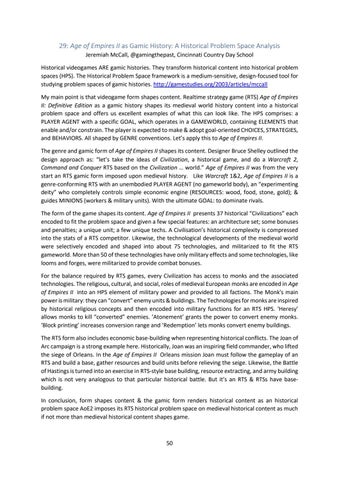29: Age of Empires II as Gamic History: A Historical Problem Space Analysis Jeremiah McCall, @gamingthepast, Cincinnati Country Day School Historical videogames ARE gamic histories. They transform historical content into historical problem spaces (HPS). The Historical Problem Space framework is a medium-sensitive, design-focused tool for studying problem spaces of gamic histories. http://gamestudies.org/2003/articles/mccall My main point is that videogame form shapes content. Realtime strategy game (RTS) Age of Empires II: Definitive Edition as a gamic history shapes its medieval world history content into a historical problem space and offers us excellent examples of what this can look like. The HPS comprises: a PLAYER AGENT with a specific GOAL, which operates in a GAMEWORLD, containing ELEMENTS that enable and/or constrain. The player is expected to make & adopt goal-oriented CHOICES, STRATEGIES, and BEHAVIORS. All shaped by GENRE conventions. Let’s apply this to Age of Empires II. The genre and gamic form of Age of Empires II shapes its content. Designer Bruce Shelley outlined the design approach as: “let’s take the ideas of Civilization, a historical game, and do a Warcraft 2, Command and Conquer RTS based on the Civilization … world.” Age of Empires II was from the very start an RTS gamic form imposed upon medieval history. Like Warcraft 1&2, Age of Empires II is a genre-conforming RTS with an unembodied PLAYER AGENT (no gameworld body), an “experimenting deity” who completely controls simple economic engine (RESOURCES: wood, food, stone, gold); & guides MINIONS (workers & military units). With the ultimate GOAL: to dominate rivals. The form of the game shapes its content. Age of Empires II presents 37 historical “Civilizations” each encoded to fit the problem space and given a few special features: an architecture set; some bonuses and penalties; a unique unit; a few unique techs. A Civilisation’s historical complexity is compressed into the stats of a RTS competitor. Likewise, the technological developments of the medieval world were selectively encoded and shaped into about 75 technologies, and militarized to fit the RTS gameworld. More than 50 of these technologies have only military effects and some technologies, like looms and forges, were militarized to provide combat bonuses. For the balance required by RTS games, every Civilization has access to monks and the associated technologies. The religious, cultural, and social, roles of medieval European monks are encoded in Age of Empires II into an HPS element of military power and provided to all factions. The Monk's main power is military: they can “convert” enemy units & buildings. The Technologies for monks are inspired by historical religious concepts and then encoded into military functions for an RTS HPS. ‘Heresy’ allows monks to kill “converted” enemies. ‘Atonement’ grants the power to convert enemy monks. ‘Block printing’ increases conversion range and ‘Redemption’ lets monks convert enemy buildings. The RTS form also includes economic base-building when representing historical conflicts. The Joan of Arc campaign is a strong example here. Historically, Joan was an inspiring field commander, who lifted the siege of Orleans. In the Age of Empires II Orleans mission Joan must follow the gameplay of an RTS and build a base, gather resources and build units before relieving the seige. Likewise, the Battle of Hastings is turned into an exercise in RTS-style base building, resource extracting, and army building which is not very analogous to that particular historical battle. But it’s an RTS & RTSs have basebuilding. In conclusion, form shapes content & the gamic form renders historical content as an historical problem space AoE2 imposes its RTS historical problem space on medieval historical content as much if not more than medieval historical content shapes game.
50









